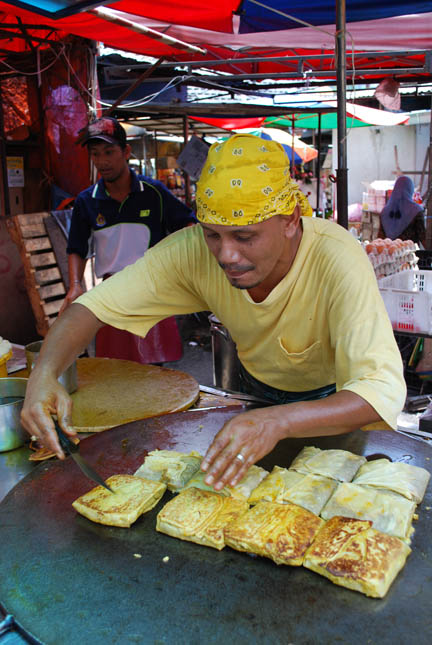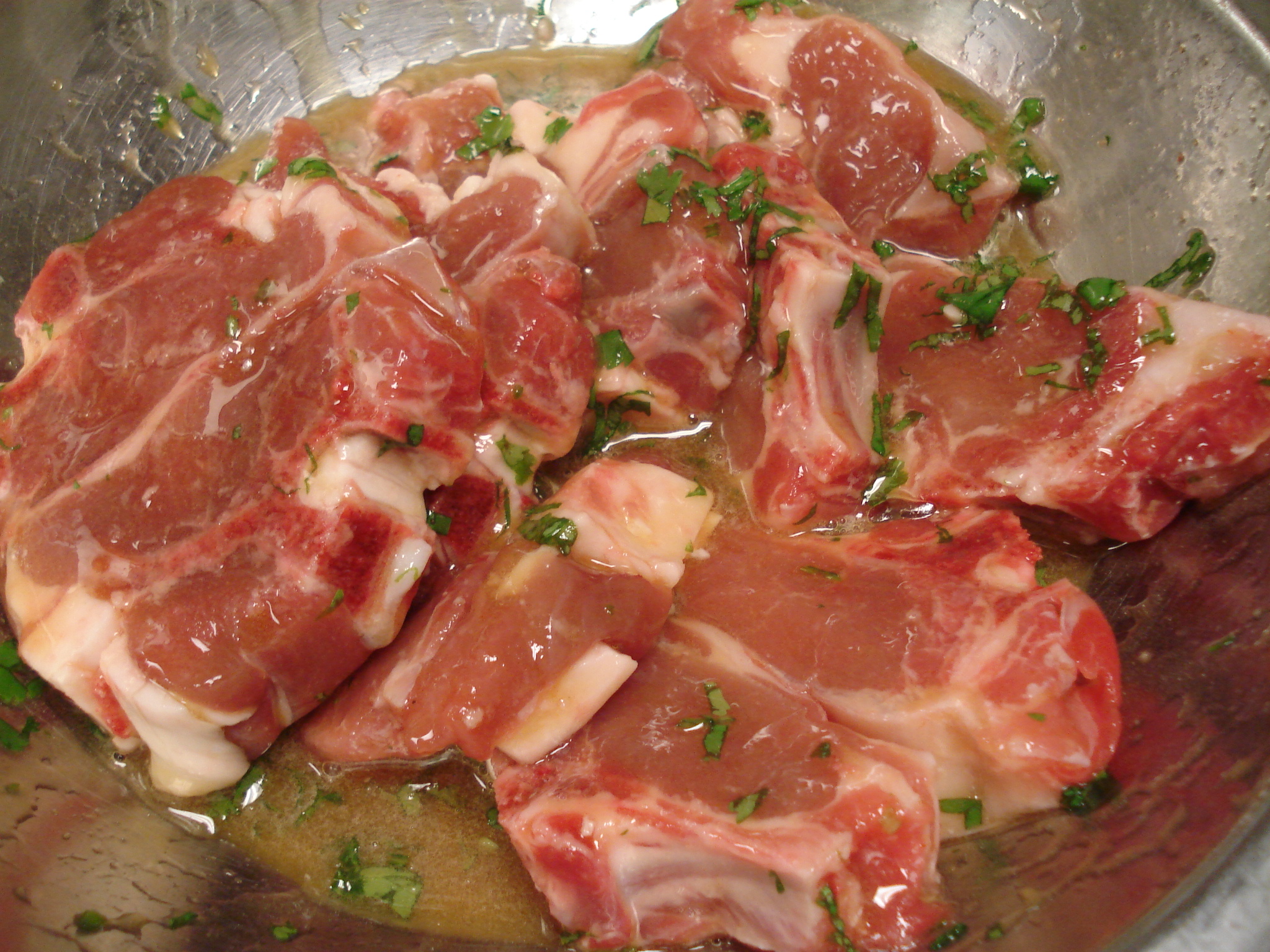|
Murtabak
Murtabak, or Mutabbaq (, ), is a Yemeni stuffed pancake or pan-fried bread commonly found in the Arabian Peninsula, the Indian subcontinent, and Southeast Asia, notably in Saudi Arabia, Yemen, Indonesia, Malaysia, Singapore, Brunei, and Southern Thailand. Depending on the location, the name and ingredients can vary significantly. The name ''mutabbaq'' means "folded" in Arabic. Murtabak is often described as a spicy folded omelette or pancake with bits of vegetables. Its most common form is made from pan-fried crepes, usually stuffed with beaten eggs, chopped leeks, chives, or green onion, and minced meat, which is then folded and cut into squares. In Malaysia, murtabak was originally sold in mamak stalls, and usually includes minced meat (beef or chicken, sometimes goat meat or mutton) along with garlic, egg, and onion, and is eaten with curry, sliced cucumber, syrup-pickled onions, or tomato sauce. In Indonesia, the term ''martabak'' refers to two dishes: '' martabak man ... [...More Info...] [...Related Items...] OR: [Wikipedia] [Google] [Baidu] |
Apam Balik
''Appam, Apam balik'' (; Jawi script, Jawi: ) also known as ''martabak manis'' (), ''terang bulan'' (), peanut pancake or ''mànjiānguǒ'' (), is a sweet dessert originating in Fujian cuisine which now consists of many varieties at specialist roadside stalls or restaurants throughout Brunei, Indonesia, Malaysia and Singapore. It can also be found in Hong Kong as (), Taiwan as (), Southern Thailand as ''Khanom Thang Taek'' (ขนมถังแตก) and in the Sulu Archipelago, Philippines as ''Tarambulan''. Origins The origins of Apam balik / 曼煎粿 attributes its invention to Zuo Zongtang, a military leader of the late Qing dynasty. In 1855, the army of the Taiping Heavenly Kingdom invaded the Fujian region and General Zuo was appointed to lead an army to crush the rebels. To provide the soldiers with food without interfering the life of local people, General Zuo decided to switch from the flatbread which was eaten together with spring onion and chilli sauce, to a p ... [...More Info...] [...Related Items...] OR: [Wikipedia] [Google] [Baidu] |
Mamak Stall
Mamak stalls are indoor and open-air food establishments found in Southeast Asia, especially in Malaysia and Singapore, that typically serve food derived from Indian cuisine, Indian Muslim and Pakistani cuisine, Pakistani cuisines, unique to the region. History Mamak stalls originate from Tamil Muslim, Tamil Muslims, most of whom migrated from South India and British Ceylon, Ceylon (modern-day Sri Lanka) to the Malay Peninsula and other locations in Southeast Asia centuries ago. They are regarded as part of the "Malaysian Indian/Singaporean Indian" community, or "Straits Indian". Archaeological findings in the Bujang Valley of Kedah suggest a trade relationship with India as early as the 1st to 5th century C.E. An inscription dated 779 AD that refers to the trade relationship between the Tamilakam and the region was found in Nakhon Si Thammarat, Southern Thailand, dating to the Nakhon Si Thammarat Kingdom. The word "mamak" is from the Tamil language, Tamil term for maternal ... [...More Info...] [...Related Items...] OR: [Wikipedia] [Google] [Baidu] |
Arabian Peninsula
The Arabian Peninsula (, , or , , ) or Arabia, is a peninsula in West Asia, situated north-east of Africa on the Arabian plate. At , comparable in size to India, the Arabian Peninsula is the largest peninsula in the world. Geographically, the Arabian Peninsula comprises Bahrain, Kuwait, Oman, Qatar, Saudi Arabia, the United Arab Emirates (UAE) and Yemen, as well as southern Iraq and Jordan. The largest of these is Saudi Arabia. In the Roman era, the Sinai Peninsula was also considered a part of Arabia. The Arabian Peninsula formed as a result of the rifting of the Red Sea between 56 and 23 million years ago, and is bordered by the Red Sea to the west and south-west, the Persian Gulf and the Gulf of Oman to the north-east, the Levant and Mesopotamia to the north and the Arabian Sea and the Indian Ocean to the south-east. The peninsula plays a critical geopolitical role in the Arab world and globally due to its vast reserves of petroleum, oil and natural gas. Before the mod ... [...More Info...] [...Related Items...] OR: [Wikipedia] [Google] [Baidu] |
Filo
Filo or phyllo is a very thin unleavened dough used for making pastries such as baklava and '' börek'' in Middle Eastern and Balkan cuisines. Filo-based pastries are made by layering many sheets of filo brushed with oil or butter; the pastry is then baked. Name and etymology The name ''filo'' or ''phyllo'' comes from Greek 'thin sheet'.Alan Davidson (2014). '' The Oxford Companion to Food'. Oxford: Oxford University Press. . p. 307. History The origin of the practice of stretching raw dough into paper-thin sheets is unclear, with many cultures claiming credit.Mayer, Caroline E.Phyllo Facts. Washington Post. 1989Archived Most say that it was derived from the Greeks; Homer's ''Odyssey'', written around 800 BC, mentions thin breads sweetened with walnuts and honey. In the fifth century BC, Philoxenos states in his poem "''Dinner''" that, in the final drinking course of a meal, hosts would prepare and serve cheesecake made with milk and honey that was baked into a pie. ... [...More Info...] [...Related Items...] OR: [Wikipedia] [Google] [Baidu] |
Old City Of Jerusalem
The Old City of Jerusalem (; ) is a walled area in Jerusalem. In a tradition that may have begun with an 1840s British map of the city, the Old City is divided into four uneven quarters: the Muslim Quarter, the Christian Quarter, the Armenian Quarter, and the Jewish Quarter. A fifth area, the Temple Mount, known to Muslims as Al-Aqsa or ''Haram al-Sharif'', is home to the Dome of the Rock, the Al-Aqsa Mosque, and was once the site of the Jewish Temple. The Old City's current walls and city gates were built by the Ottoman Empire from 1535 to 1542 under Suleiman the Magnificent. The Old City is home to several sites of key importance and holiness to the three major Abrahamic religions: the Temple Mount and the Western Wall for Judaism, the Church of the Holy Sepulchre for Christianity, and the Dome of the Rock and al-Aqsa Mosque for Islam. The Old City, along with its walls, was added to the World Heritage Site list of UNESCO in 1981. In spite of its name, the Old City ... [...More Info...] [...Related Items...] OR: [Wikipedia] [Google] [Baidu] |
Ottoman Empire
The Ottoman Empire (), also called the Turkish Empire, was an empire, imperial realm that controlled much of Southeast Europe, West Asia, and North Africa from the 14th to early 20th centuries; it also controlled parts of southeastern Central Europe, between the early 16th and early 18th centuries. The empire emerged from a Anatolian beyliks, ''beylik'', or principality, founded in northwestern Anatolia in by the Turkoman (ethnonym), Turkoman tribal leader Osman I. His successors Ottoman wars in Europe, conquered much of Anatolia and expanded into the Balkans by the mid-14th century, transforming their petty kingdom into a transcontinental empire. The Ottomans ended the Byzantine Empire with the Fall of Constantinople, conquest of Constantinople in 1453 by Mehmed II. With its capital at History of Istanbul#Ottoman Empire, Constantinople (modern-day Istanbul) and control over a significant portion of the Mediterranean Basin, the Ottoman Empire was at the centre of interacti ... [...More Info...] [...Related Items...] OR: [Wikipedia] [Google] [Baidu] |
Arabic
Arabic (, , or , ) is a Central Semitic languages, Central Semitic language of the Afroasiatic languages, Afroasiatic language family spoken primarily in the Arab world. The International Organization for Standardization (ISO) assigns language codes to 32 varieties of Arabic, including its standard form of Literary Arabic, known as Modern Standard Arabic, which is derived from Classical Arabic. This distinction exists primarily among Western linguists; Arabic speakers themselves generally do not distinguish between Modern Standard Arabic and Classical Arabic, but rather refer to both as ( "the eloquent Arabic") or simply ' (). Arabic is the List of languages by the number of countries in which they are recognized as an official language, third most widespread official language after English and French, one of six official languages of the United Nations, and the Sacred language, liturgical language of Islam. Arabic is widely taught in schools and universities around the wo ... [...More Info...] [...Related Items...] OR: [Wikipedia] [Google] [Baidu] |
Scallion
Scallions (also known as green onions and spring onions) are edible vegetables of various species in the genus ''Allium''. Scallions generally have a milder taste than most onions. Their close relatives include garlic, shallots, leeks, chives, and Allium chinense, Chinese onions. The leaves are eaten both raw and cooked. Scallions produce hollow, tubular, green leaves that grow directly from the bulb, which does not fully develop. This is different to other ''Allium'' species where bulbs fully develop, such as commercially available onions and garlic. With scallions, the leaves are what is typically chopped into various dishes and used as garnishes. Etymology and naming The names ''scallion'' and ''shallot'' derive from the Old French ''eschalotte'', by way of ''eschaloigne'', from the Latin ''Ascalōnia caepa'' or "Ascalonian onion", a namesake of the ancient Eastern Mediterranean coastal city of Ascalon. Other names used in various parts of the world include spring onion ... [...More Info...] [...Related Items...] OR: [Wikipedia] [Google] [Baidu] |
Goat Meat
Goat meat is the meat of the domestic goat (''Capra hircus''). The term 'goat meat' denotes meat of older animals, while meat from young goats is called 'kid meat'. In South Asian cuisine, goat meat is called mutton, along with sheep meat.''Oxford English Dictionary'', 3rd edition, June 2003blend of "goat" in French and "sheep" in French, was coined in 1922 and selected by a trade association; it was adopted by the United States Department of Agriculture in 1928, however the term never caught on and is not encountered in the United States. "Cabrito", a word in Spanish and Portuguese, is the meat of a young, milk-fed goat. It is also known as chivo meat. In cuisine Goat meat is both a staple and a delicacy in the world's cuisines. The cuisines best known for their use of goat include African cuisine, Middle Eastern, Indian, Indonesian, Nepali, Bangladeshi, Pakistani, Abruzzese, Mexican, Caribbean (Jamaica), Haitian cuisine, Dominican cuisine and Ecuadorian. Cab ... [...More Info...] [...Related Items...] OR: [Wikipedia] [Google] [Baidu] |
Ground Meat
Ground meat, called mince or minced meat outside North America, is meat finely chopped by a meat grinder or a chopping knife. A common type of ground meat is ground beef, but many other types of meats are prepared in a similar fashion, including pork, veal, lamb, goat meat, and poultry. Dishes Ground meat is used in a wide variety of dishes, by itself, or mixed with other ingredients. It may be formed into meatballs which are then fried, baked, steamed, or braised. They may be cooked on a skewer to produce dishes such as '' adana kebabı'' and '' ćevapi''. It may be formed into patties which are then grilled or fried (hamburger), breaded and fried ('' menchi-katsu'', Pozharsky cutlet), or braised ( Salisbury steak). It may be formed into meatloaves or pâtés and baked. It may also be used as a filling or stuffing for meat pies such as shepherd's pie and '' böreks'', and also as stuffing. It may be cooked and served as a hash or loosemeat. It may be made into mea ... [...More Info...] [...Related Items...] OR: [Wikipedia] [Google] [Baidu] |








